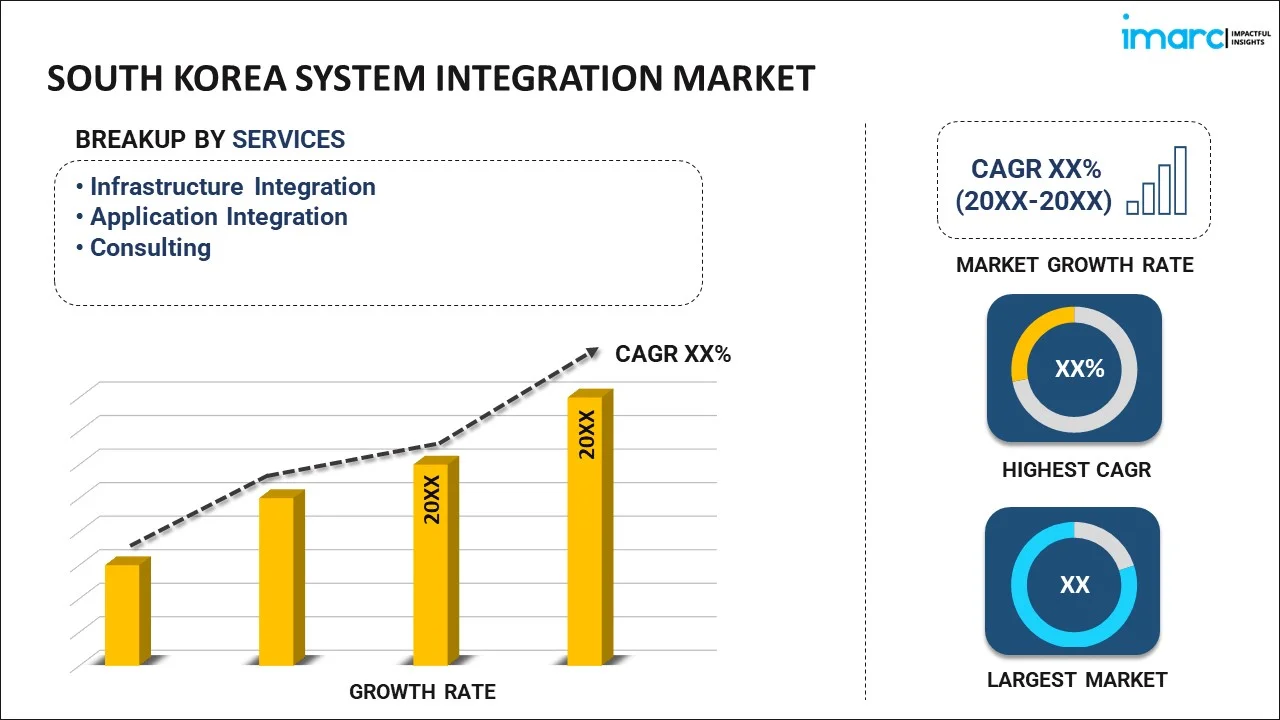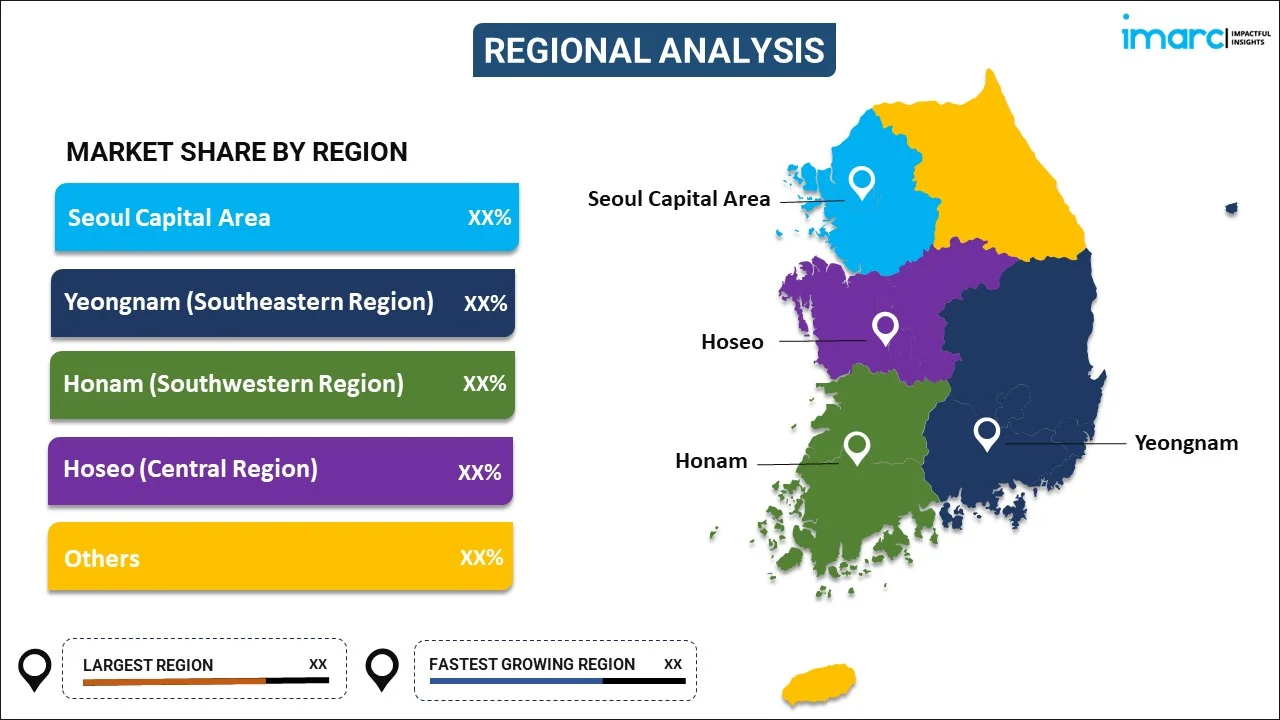
South Korea System Integration Market Report by Service (Infrastructure Integration, Application Integration, Consulting), End Use Industry (BFSI, Government, Manufacturing, Telecommunications, Retail, Oil and Gas, Healthcare, and Others), and Region 2024-2032
Market Overview:
South Korea system integration market size is projected to exhibit a growth rate (CAGR) of 6.60% during 2024-2032. The rising emphasizes of numerous organizations to achieve seamless connectivity, real-time data insights, and faster decision-making processes is primarily bolstering the market growth across the country.
|
Report Attribute
|
Key Statistics
|
|---|---|
|
Base Year
|
2023 |
|
Forecast Years
|
2024-2032
|
|
Historical Years
|
2018-2023
|
| Market Growth Rate (2024-2032) | 6.60% |
System integration involves the linking of both physical and digital components within information technology (IT) infrastructure. This encompasses the connection of machine systems, inventory, databases, applications, protocols, formats, and data usage patterns into a unified network. The purpose of system integration is to address the challenges associated with heightened communication between various systems, ultimately enhancing productivity and ensuring data consistency. In the contemporary landscape, organizations across diverse industries leverage system integration solutions as a strategic approach to reduce infrastructure investments and expedite decision-making processes.
South Korea System Integration Market Trends:
The South Korea system integration market has emerged as a critical component in the nation's technological landscape, driving efficiency, connectivity, and streamlined operations across various industries. Additionally, organizations in South Korea are increasingly turning to system integration solutions to address the complexities arising from the growing need for seamless communication between diverse systems. This integration not only enhances overall productivity but also ensures data consistency and reliability in an interconnected digital environment. Moreover, the South Korea system integration market plays a pivotal role in helping enterprises overcome technological challenges, making their operations more agile, responsive, and capable of adapting to evolving industry demands. One of the significant advantages offered by system integration in the country is its ability to minimize infrastructural investments. By integrating existing systems and technologies, organizations can optimize their resources and enhance operational efficiency without the need for substantial capital expenditures. This approach aligns with the business objectives of cost-effectiveness and sustainability. Organizations in South Korea, spanning various end-use industries, including manufacturing, finance, healthcare, and telecommunications, are leveraging system integration solutions, thereby acting as significant growth-inducing factor. As South Korea continues to be at the forefront of technological advancements, the system integration market is poised for sustained growth, playing a crucial role in shaping the digital transformation journey of businesses across the nation in the coming years.Top of Form
South Korea System Integration Market Segmentation:
IMARC Group provides an analysis of the key trends in each segment of the market, along with forecasts at the country level for 2024-2032. Our report has categorized the market based on service and end use industry.
Service Insights:

- Infrastructure Integration
- Application Integration
- Consulting
The report has provided a detailed breakup and analysis of the market based on the service. This includes infrastructure integration, application integration, and consulting.
End Use Industry Insights:
- BFSI
- Government
- Manufacturing
- Telecommunications
- Retail
- Oil and Gas
- Healthcare
- Others
A detailed breakup and analysis of the market based on the end use industry have also been provided in the report. This includes BFSI, government, manufacturing, telecommunications, retail, oil and gas, healthcare, and others.
Regional Insights:

- Seoul Capital Area
- Yeongnam (Southeastern Region)
- Honam (Southwestern Region)
- Hoseo (Central Region)
- Others
The report has also provided a comprehensive analysis of all the major regional markets, which include Seoul Capital Area, Yeongnam (Southeastern Region), Honam (Southwestern Region), Hoseo (Central Region), and Others.
Competitive Landscape:
The market research report has also provided a comprehensive analysis of the competitive landscape. Competitive analysis such as market structure, key player positioning, top winning strategies, competitive dashboard, and company evaluation quadrant has been covered in the report. Also, detailed profiles of all major companies have been provided.
South Korea System Integration Market Report Coverage:
| Report Features | Details |
|---|---|
| Base Year of the Analysis | 2023 |
| Historical Period | 2018-2023 |
| Forecast Period | 2024-2032 |
| Units | US$ Million |
| Scope of the Report | Exploration of Historical and Forecast Trends, Industry Catalysts and Challenges, Segment-Wise Historical and Predictive Market Assessment:
|
| Services Covered | Infrastructure Integration, Application Integration, Consulting |
| End Use Industries Covered | BFSI, Government, Manufacturing, Telecommunications, Retail, Oil and Gas, Healthcare, Others |
| Regions Covered | Seoul Capital Area, Yeongnam (Southeastern Region), Honam (Southwestern Region), Hoseo (Central Region), Others |
| Customization Scope | 10% Free Customization |
| Report Price and Purchase Option | Single User License: US$ 3699 Five User License: US$ 4699 Corporate License: US$ 5699 |
| Post-Sale Analyst Support | 10-12 Weeks |
| Delivery Format | PDF and Excel through Email (We can also provide the editable version of the report in PPT/Word format on special request) |
Key Questions Answered in This Report:
- How has the South Korea system integration market performed so far and how will it perform in the coming years?
- What has been the impact of COVID-19 on the South Korea system integration market?
- What is the breakup of the South Korea system integration market on the basis of service?
- What is the breakup of the South Korea system integration market on the basis of end use industry?
- What are the various stages in the value chain of the South Korea system integration market?
- What are the key driving factors and challenges in the South Korea system integration?
- What is the structure of the South Korea system integration market and who are the key players?
- What is the degree of competition in the South Korea system integration market?
Key Benefits for Stakeholders:
- IMARC’s industry report offers a comprehensive quantitative analysis of various market segments, historical and current market trends, market forecasts, and dynamics of the South Korea system integration market from 2018-2032.
- The research report provides the latest information on the market drivers, challenges, and opportunities in the South Korea system integration market.
- Porter's five forces analysis assist stakeholders in assessing the impact of new entrants, competitive rivalry, supplier power, buyer power, and the threat of substitution. It helps stakeholders to analyze the level of competition within the South Korea system integration industry and its attractiveness.
- Competitive landscape allows stakeholders to understand their competitive environment and provides an insight into the current positions of key players in the market.
Need more help?
- Speak to our experienced analysts for insights on the current market scenarios.
- Include additional segments and countries to customize the report as per your requirement.
- Gain an unparalleled competitive advantage in your domain by understanding how to utilize the report and positively impacting your operations and revenue.
- For further assistance, please connect with our analysts.
 Inquire Before Buying
Inquire Before Buying
 Speak to an Analyst
Speak to an Analyst
 Request Brochure
Request Brochure
 Request Customization
Request Customization




.webp)




.webp)












